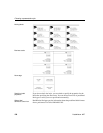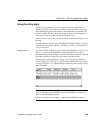
CHAPTER 4 Defining DataWindow Objects
DataWindow Designer User’s Guide 111
If the data is in the
database
If the data for the DataWindow object will be retrieved from a database, choose
one of the following data sources:
If the data is not in a
database
Select the External data source if:
• The DataWindow object will be populated programmatically.
• Data will be imported from an external file, such as an XML,
comma-separated values (CSV ), tab-separated text (TXT ), or dBASE
(DBF) file.
You can also use an ODBC driver to access data from a file. DataWindow
Designer includes ODBC drivers for most file types.
For more information, see Connecting to Your Database.
After you choose a data source in the various DataWindow wizards, you
specify the data. The data source you choose determines what displays in the
wizards and how you define the data.
Why use a
DataWindow if the
data is not from a
DBMS
Even when the data is not coming from the database, there are many times
when you want to take advantage of the intelligence of a DataWindow object:
•Data ValidationYou have full access to validation rules for data
• Display Formats You can use any existing display formats to present the
data, or create your own
•Edit StylesYou can use any existing edit styles, such as radio buttons
and edit masks, to present the data, or create your own
Data source Use when
Quick Select The data is from a single table (or from tables that are related
through foreign keys) and you need only to choose columns,
selection criteria, and sorting.
SQL Select You want more control over the SQL
SELECT statement
generated for the data source or your data is from tables that
are not connected through a key. For example, you need to
specify grouping, computed columns, or retrieval arguments
within the SQL SELECT statement.
Query The data has been defined as a query.
Stored Procedure The data is defined in a stored procedure.
ADO DataSet You are using an ADO DataSet for data access and you want
to use the DataWindow as a presentation tool.


















